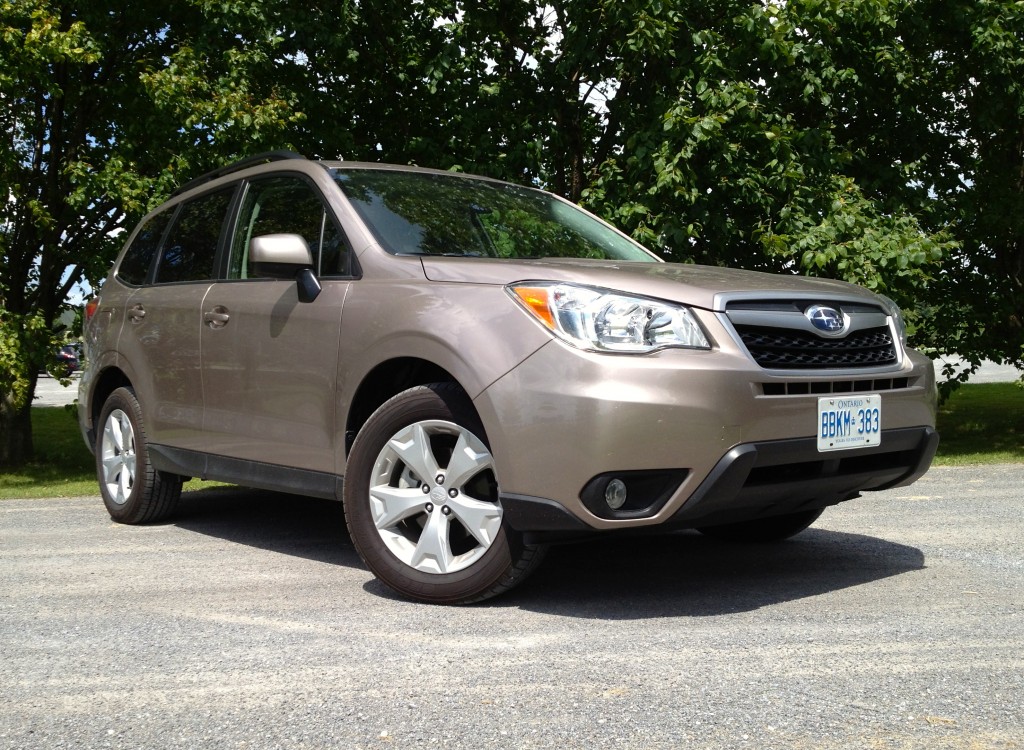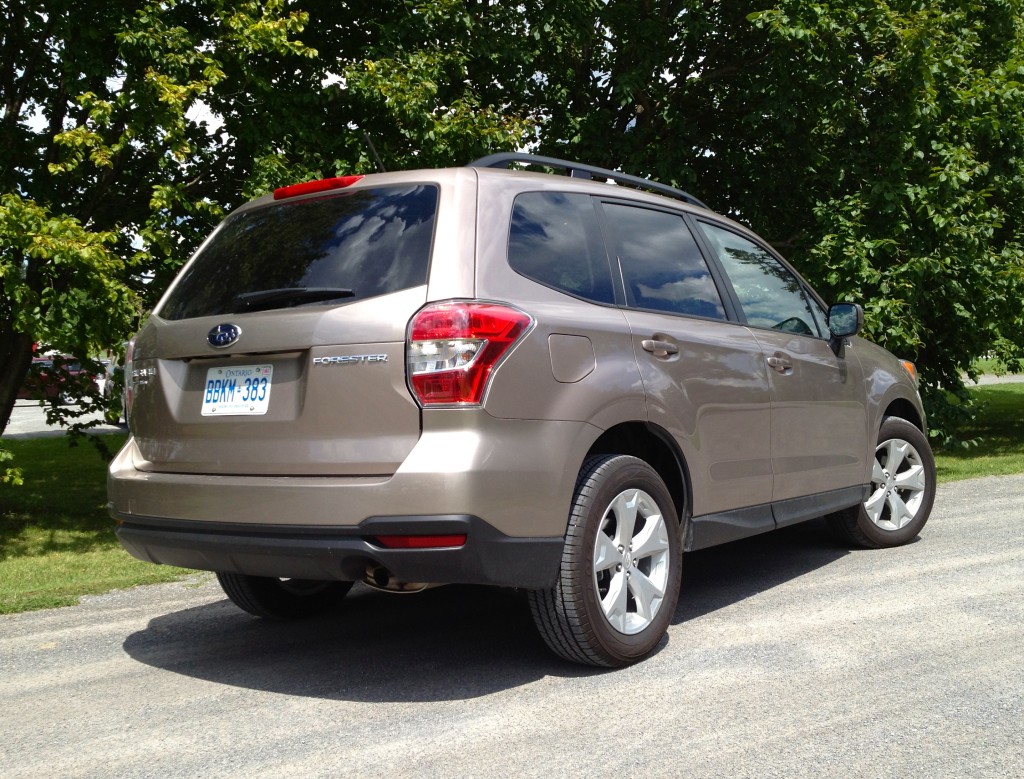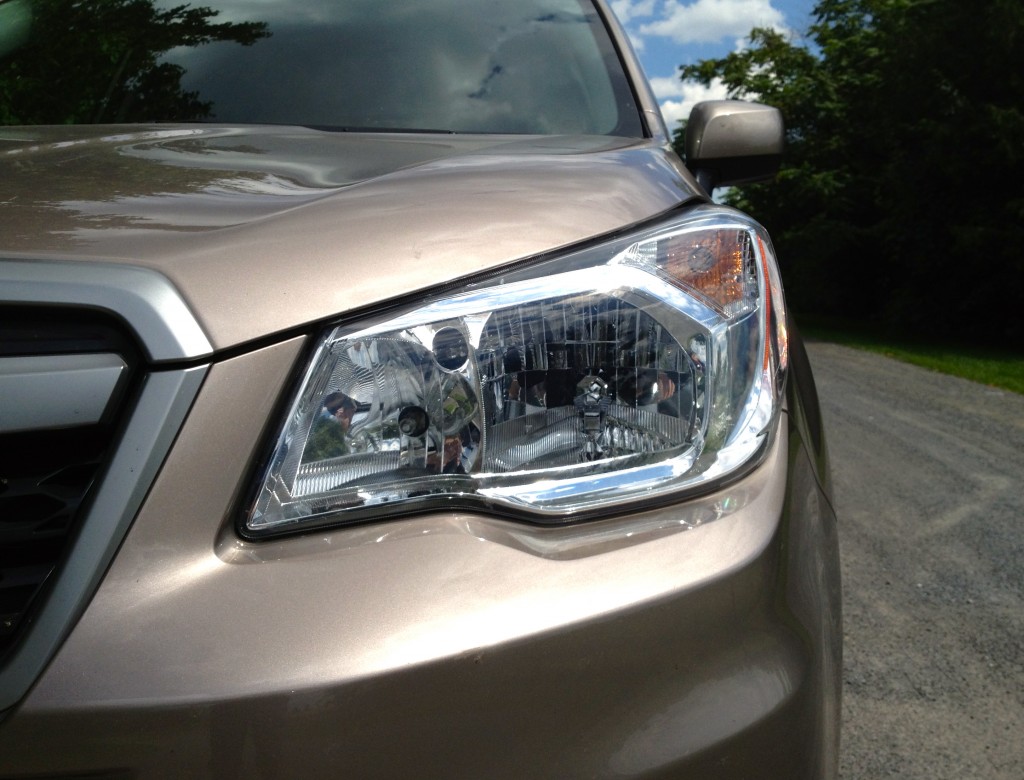Road Test: 2014 Subaru Forester 2.5i
Story and photos by John LeBlanc
Always a comfortable, modest and casual driving machine since the first version arrived in 1997, it’s been easy to think of the Subaru Forester as the Birkenstock sandal of the compact crossover crowd. However, like the current Subaru Impreza compact and slick-looking Legacy Concept from last month’s Los Angeles auto show, the Japanese automaker seems to be moving the all-new, 2014 Forester towards more mainstream Nike sneaker buyers.
To better battle compact crossover rivals like the Ford Escape, Honda CR-V and Toyota RAV4, the fourth-generation, five-passenger, all-wheel-drive Forester is bigger inside and out, has more high-tech goodies, and a few mechanical upgrades, too.
The topline, $34,145 (all prices include freight and pre-delivery inspection fees) 2014 Forester 2.0XT Touring is a good example of Subaru trying to run with the best sellers in this class. The 2.0XT’s new 250-horsepower turbocharged 2.0-litre gas engine, producing 258 pound-feet of torque, is only challenged by the Escape’s 231 hp and 270 lb-ft 2.0L turbo-four. But I did not drive that Forester.
Instead, my tester was a base model Forester 2.5i. Its $30,795 price included a $1,300 continuously variable automatic transmission and an $1,800 Convenience package that added a 10-way power adjustable driver’s seat, backup camera as part of an upgraded centre dash information screen, paddle shifters, 17-inch alloy wheels, rear cargo cover and automatic headlamps.
As a point of reference, a $30,914 Ford Escape SE 4WD, $29,985 Honda CR-V LX and $30,890 Toyota RAV4 AWD XLE are all comparatively equipped and competitively priced.
Some fans of Subaru’s rally car-inspired WRX sports compacts have asked why the Japanese automaker doesn’t offer a “Forester WRX”. For them, the Forester 2.0XT may come closest to offering a bit more performance in this practical package. But between its modest horsepower and the new, fuel-efficiency-first CVT, my Forester 2.5i could only manage a lacklustre zero to 100 km/hr acceleration time of almost nine seconds. That’s not only slower than its rivals, it almost guarantees the Subie cute-ute won’t be seen at the starting line of any rallies anytime soon.
Deciphered, the “2.5i” badge on the Forester’s rump translates to a carryover, non-turbocharged 2.5 L four-cylinder gas engine that makes 80 less horsepower and 84 less lb-ft of torque than the Forester 2.0XT. The 2.0XT Forester’s CVT gets artificial gear change programming. The 2.5i models do not, and makes the Convenience package’s paddle shifters seemingly for show only.
Not only is the Forester 2.5i slow, you’re also saddled with the typical CVT behaviour that feels like the transmission is one step behind the engine when you put down your right foot on the throttle. When trying to time the acceleration runs, the Forester 2.5i’s CVT acted like an on-off button: at first push, there’s little reaction from the engine department, then a flood of revs that create more noise and commotion than actual forward acceleration.
The Forester 2.5i’s CVT doesn’t help much if you’re a compact crossover owner who needs to tow, too. While its rivals can haul as much as 680 kilograms, the Subaru’s towing capacity is limited to just 453.
Of course, one big reason automakers are jamming CVTs where conventional automatics use to be are the benefits of improved fuel economy. In that regard, the 2014 Forester scores over its predecessor. With 8.3 litres per 100 km city and 6.2 highway estimates, this year’s Forester 2.5i is more efficient than the 2013 model’s respective 9.9 and 7.5 numbers. In my time with the Subaru, I recorded a 10.8 L/100 km average. That said, enthusiasts should stick with the 2014 Forester’s six-speed manual gearbox. Its 9.4 L/100 km city and 7.1 highway ratings don’t exactly make it a gas guzzler, and Subaru’s hill-holder feature makes it even easier to drive for inexperienced stick-shift drivers.
As before, the Japanese automaker makes AWD standard on every 2014 Forester. CVT-equipped models get a slightly different setup than the manuals. Dubbed X-Mode, Subaru has managed to get the Forester’s engine, transmission and brakes to work together to dollop out torque independently to all four wheels for the best traction possible. I drove this vehicle before the snow fell. But when driven briskly in dry corners, I could feel the X-Mode working from front-back and side-to-side.
And although these types of light duty vehicles rarely leave the pavement, the 2014 Forester gains a bit more ground clearance this year (Subaru says a class-leading 221 millimetres) to help navigate over unplowed laneways or deeply furrowed cottage roads.
As good as the Forester’s new X-Mode is, it couldn’t stop the 2014 Forester 2.5i from rolling too much in the corners and it didn’t deliver more feel from the electric steering system. Unlike the fine driving Escape, the Forester 2.5i seems tuned for comfort first, which it delivers, especially over bad pavement. Wannabe rally drivers also won’t be pleased that the Subaru’s front seats don’t offer much in the way of lateral support.
So the 2014 Forester 2.5i is no rally car. But at least its roomier cabin is now on par with its rivals for passenger and cargo space. The Subaru’s seating has been raised for better outward visibility (something not to be taken lightly in an era where high waistlines can sometimes make seeing out of vehicles nearly impossible). In the second row, only NBA starters would have reason to complain about the amount of leg- and head-room — it’s that spacious. And rear cargo space goes from 949 litres to 974 over last year’s Forester.
For you shoe buyers out there, feel free to call the new 2.5i the BirkeNike of Foresters. The Forester 2.5i is less of a radical departure than the turbocharged 2.0XT models. With arguably the most sophisticated AWD system in its class, lots of ground clearance and a comfort-first driving demeanour, the Forester 2.5i won’t scare off existing Subaru fans.
Road Test: 2014 Subaru Forester 2.5i
Type of vehicle All-wheel-drive compact crossover
Engine 2.5L DOHC four-cylinder boxer
Power 170 hp @ 5,800 rpm, 174 lb.-ft. of torque @ 4,100 rpm
Transmission Continuously variable automatic
Brakes Four-wheel disc with ABS
Tires P225/60R17
Price (base/as tested) $25,995/$30,745
Destination charge $1,650
Natural Resources Canada fuel economy (L/100 km) 8.3 city, 6.2 highway, 10.8 as-tested
Standard features AM/FM/CD/MP3/WMA four-speaker audio system, Bluetooth phone connectivity with voice activation and steering wheel-mounted controls with Bluetooth streaming, iPod/USB audio integration, tilt-adjustable, telescopic steering wheel, premium cloth upholstery, six-way manually adjustable driver’s seat, 60/40-split, flat-folding rear seats, Vehicle Dynamics Control system with lateral-g and yaw-rate sensor, traction control system, keyless entry security system with panic alarm, and more
Options $1,300 CVT; $1,800 Convenience package












![[del.icio.us]](https://www.straight-six.com/wp-content/plugins/bookmarkify/delicious.png)
![[Digg]](https://www.straight-six.com/wp-content/plugins/bookmarkify/digg.png)
![[Facebook]](https://www.straight-six.com/wp-content/plugins/bookmarkify/facebook.png)
![[Google]](https://www.straight-six.com/wp-content/plugins/bookmarkify/google.png)
![[Reddit]](https://www.straight-six.com/wp-content/plugins/bookmarkify/reddit.png)
![[StumbleUpon]](https://www.straight-six.com/wp-content/plugins/bookmarkify/stumbleupon.png)
![[Twitter]](https://www.straight-six.com/wp-content/plugins/bookmarkify/twitter.png)
![[Email]](https://www.straight-six.com/wp-content/plugins/bookmarkify/email.png)